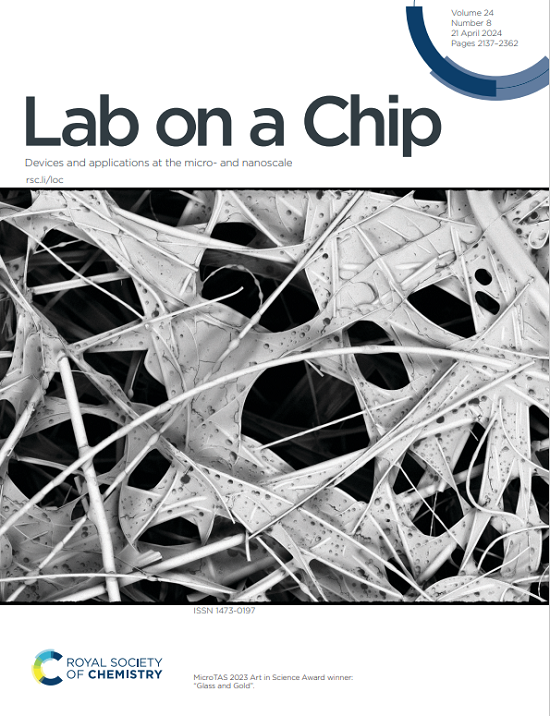昆虫翅膀循环:通过微流控蜻蜓前翼模型进行瞬态灌注。
IF 6.1
2区 工程技术
Q1 BIOCHEMICAL RESEARCH METHODS
引用次数: 0
摘要
昆虫的翅膀是由一种非细胞复合材料制成的,它形成了一层薄膜和一个复杂的静脉网络。静脉不仅是用来稳定翅膀膜的管道,而且它们也充满了血淋巴(昆虫的血液)。因此,静脉为位于翼静脉上的感觉器官提供水和营养,并使废物得以清除。此外,翅膀的复合材料是由血淋巴永久水合,从而保持必要的灵活性。因此,通过微流控静脉网络的血淋巴流动对昆虫翅膀的功能至关重要。然而,灌注如何在整个静脉网络中发生与血淋巴循环的关系尚不清楚。为了研究复杂翅脉的瞬态灌注动力学,我们利用聚二甲基硅氧烷建立了普通绿翅蜻蜓(Anax junius)前翅的微流控翅脉模型。通过向充满清水的模型注射染料来模拟瞬时灌注;相反,在另一项试验中,将清水注入染料中。可视化的灌注模式表明,静脉网络的灌注部分随时间呈对数增长,这可以用简化翼静脉网络的理论模型来解释,并且在静脉中新物质的到达和旧物质的完全去除之间存在时间差异。我们的仿生翼静脉装置可以进一步研究昆虫翅膀独特的循环系统和运输现象。此外,我们基于微流体的方法证明了微流体在昆虫学和相关领域的潜在应用。本文章由计算机程序翻译,如有差异,请以英文原文为准。
Insect wing circulation: transient perfusion through a microfluidic dragonfly forewing model.
Insect wings are made of an acellular composite material that forms a thin membrane and a complex network of veins. Veins are tubes that not only serve to stabilize the wing membrane, but they are also filled with hemolymph (insect blood). Thus, veins supply the sensory organs located on the wing veins with water and nutrients and enable the removal of waste products. In addition, the composite material of the wing is permanently hydrated by the hemolymph and thus retains the necessary flexibility. Hemolymph flow through the microfluidic vein network is therefore crucial for the functionality of insect wings. However, how perfusion occurs throughout the vein network in relation to hemolymph circulation is poorly understood. To investigate the dynamics of transient perfusion in complex wing venation, we developed a microfluidic wing vein model of the forewing of the common green darner dragonfly, Anax junius, using polydimethylsiloxane. Transient perfusion was simulated by injecting dye into the model filled with clear water; inversely, clear water was injected into dye in a separate trial. Visualized perfusion patterns suggest that the perfused portion of the vein network logarithmically increased with respect to time, which could be explained by a theoretical model of a simplified wing vein network, and that time differences occurred between the arrival of a new substance and the complete removal of an old substance in veins. Our biomimetic wing vein device enables further investigation into the unique circulatory system and transport phenomena of the insect wing. Also, our microfluidics-based approach proves a potential use of microfluidics in entomology and related fields.
求助全文
通过发布文献求助,成功后即可免费获取论文全文。
去求助
来源期刊

Lab on a Chip
工程技术-化学综合
CiteScore
11.10
自引率
8.20%
发文量
434
审稿时长
2.6 months
期刊介绍:
Lab on a Chip is the premiere journal that publishes cutting-edge research in the field of miniaturization. By their very nature, microfluidic/nanofluidic/miniaturized systems are at the intersection of disciplines, spanning fundamental research to high-end application, which is reflected by the broad readership of the journal. Lab on a Chip publishes two types of papers on original research: full-length research papers and communications. Papers should demonstrate innovations, which can come from technical advancements or applications addressing pressing needs in globally important areas. The journal also publishes Comments, Reviews, and Perspectives.
 求助内容:
求助内容: 应助结果提醒方式:
应助结果提醒方式:


